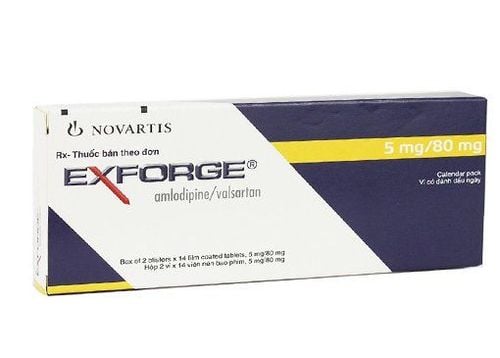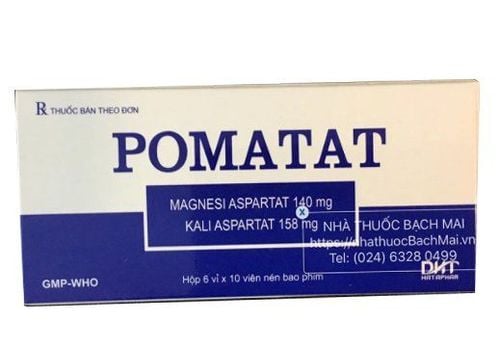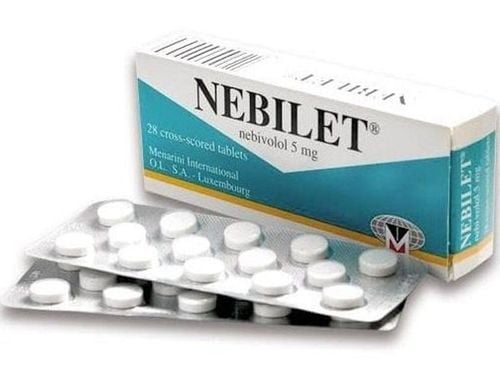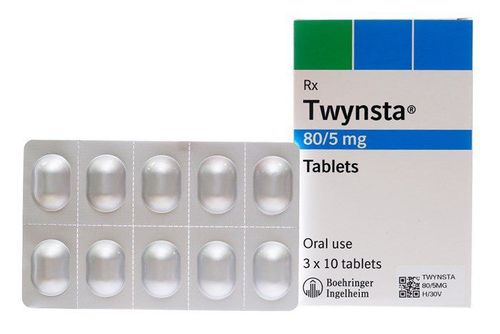This is an automatically translated article.
Aginaril is a cardiovascular drug containing the active ingredient Enalapril maleate Enalapril 5mg, an ACE inhibitor. Below is detailed information about Aginaril's uses, usage, dosage and precautions when using Aginaril medicine.
1. What are the effects of Aginaril?
Aginaril (Enalapril) is an angiotensin converting enzyme inhibitor, Aginaril has the effect of lowering blood pressure and has a good effect on hemodynamics in patients with congestive heart failure by the following mechanism:
After taking Aginaril, Enalapril converts Enalaprilat is converted to enalaprilat, which acts mainly by inhibiting the renin-angiotensin-aldosterone system. Enalapril prevents the conversion of anglotensin I to angiotensin II by inhibiting angiotensin-converting enzyme (ACE), limiting the formation of angiotensin II - a potent vasoconstrictor. On the other hand, decreased enalapril also reduces serum aldosterone concentration, thereby reducing sodium retention, increasing kallikrein-kinin vasodilatation, which can alter prostanoid metabolism and inhibit sympathetic nervous system. Enalapril also inhibits the breakdown of bradykinin, a vasodilator, because angiotensin-converting enzyme plays an important role in the breakdown of kinin.
In hypertensive patients, Enalapril reduces blood pressure by reducing total peripheral resistance (may not increase or slightly increase heart rate, cardiac output). Aginaril dilates the arteries, possibly dilating the veins. Enalapril generally reduces blood pressure (both systolic and diastolic) by about 10-15% in the lying or sitting position. People with hyponatremia or hypovolaemia may experience hypotension or an increase in heart rate when taking Aginaril.
In patients with congestive heart failure, the combination of Aginaril with diuretics and cardiac glycosides reduces total peripheral resistance, reducing afterload. Using Enalapril reduces left ventricular hypertrophy after 2-3 months of use because it inhibits the formation of angiotensin II - a strong myocardial growth stimulator.
Renal blood flow may be increased with Enalapril, but glomerular filtration rate is usually unchanged. Prolonged treatment with Enalapril may increase serum creatinine and BUN, which is common in patients with pre-existing renal injury or in patients with renal vascular hypertension, especially in those with poor perfusion of the kidneys, where renal function may be impaired. markedly deteriorated.
Enalapril increases insulin sensitivity in hypertensive patients. The drug does not reduce lipid metabolism.
It is thanks to the above mechanism of action that Aginaril is indicated in the following cases:
Treatment of hypertension (essential hypertension, hypertension due to kidney disease,...). Treatment of symptomatic heart failure. Prevention of symptomatic heart failure in patients with asymptomatic left ventricular dysfunction (EF ≤ 35%).
2. Pharmacokinetic properties of Aginaril
Absorption:
After oral administration of Aginaril, about 60% of Enalapril is absorbed from the gastrointestinal tract, food does not affect the absorption of the drug. The half-life of Enalapril is approximately 11 hours. The hemodynamic effect of the drug lasts about 24 hours. After absorption, Enalapril is extensively hydrolyzed in the liver to the metabolite enalaprilat. Peak plasma concentrations of enalaprilat are reached 3-4 hours after dosing. When taking 5mg Enalapril, the antihypertensive effect of the drug usually appears after 1 hour, reaches its maximum effect in 4-6 hours and will usually last for 12-24 hours. Enalapril lowers blood pressure gradually and it takes several weeks for full effect to be achieved.
The hemodynamic effects of Enalapril begin later and are generally longer lasting than those of Captopril. In patients with congestive heart failure, when taking a single dose of Aginaril, the drug will have a pronounced hemodynamic effect within 2-4 hours and this effect may persist for 24 hours.
Distribution:
Approximately half of Enalapril is bound to plasma proteins. Metabolism and elimination:
Aginaril is excreted in the urine and gastrointestinal tract. About 60% of the drug is excreted in the urine as enalaprilat and unchanged form, the rest is excreted in the feces from the body.
3. Usage and dosage of Aginaril
3.1. How to take Aginaril The absorption of Enalapril is not affected by food. Therefore, Aginaril can be taken before, during or after a meal. Take the medicine with water.
3.2. Dosage of Aginaril The dose of Aginaril (Enalapril 5mg) depends on the goal of treatment and is adjusted according to the patient's response.
Treatment of hypertension:
Initial dose: 5-20mg/day, taken once a day, depending on the degree of hypertension and the patient's condition. For mild hypertension: usually start with a dose of 5-10 mg. Patients with a highly activated renin-angiotensin-aldosterone system seen in renal vascular hypertension, severe hypertension, salt depletion, hypovolaemia, cardiac decompensation: a dose of 5 mg or lower should be initiated: because of the risk of hypotension and hypovolemia. If possible, the diuretic should be discontinued 2 to 3 days before starting Enalapril. These patients should be monitored for renal function and serum potassium during treatment with Enalapril. The usual maintenance dose of Enalapril is 20 mg/day, up to a maximum of 40 mg/day. Symptomatic heart failure or asymptomatic left ventricular dysfunction:
The initial dose of Enalapril is 2.5 mg/day and monitor the initial efficacy of the drug. If the therapeutic target is not achieved, the dose can be increased gradually every 2 to 4 weeks, to the usual maintenance dose of 20 mg, which can be taken once or twice a day. The maximum dose of Enalapril in this case is 40mg / day divided into 2 times a day. Dosage adjustment in renal impairment:
Creatinine clearance 30-80 ml/min: 5-10 mg Enalapril/day. Creatinine clearance 10-30 ml/min: 2.5-5 mg Enalapril/day. Creatinine clearance <10 ml/min: 2.5 mg Enalapril on the day of dialysis. Enalapril dose on non-dialysis days: adjustment for blood pressure No dose adjustment of Enalapril is required in patients with hepatic impairment.
4. Undesirable effects of Aginaril
Very common side effects:
Nervous: Dizziness. Eyes: Blurred vision. Respiratory: Cough. Gastrointestinal: Nausea. Body as a whole: Weakness. Common side effects:
Psychiatric: Depression. Neurological: Headache, syncope, change in taste. Gastrointestinal: Diarrhea, abdominal pain. Cardiovascular: Chest pain, arrhythmia, angina, hypotension (including orthostatic hypotension). Respiratory: Difficulty breathing. Skin and subcutaneous tissue: Hypersensitivity, rash, angioedema: Edema of the face, edema of the hands and feet, edema of the lips, tongue, glottis, laryngeal edema. Body as a whole: Fatigue. Laboratory tests: Hyperkalemia, increased blood creatinine. Uncommon side effects:
Anemia, hypoglycemia, nervousness, drowsiness; Paresthesia, tinnitus, palpitations, myocardial infarction, cerebrovascular accident; Sore throat, runny nose, hoarseness; Intestinal obstruction, vomiting, constipation, loss of appetite, dry mouth, stomach ulcer; Sweating, urticaria, cramps, kidney failure, uremia, hyponatremia,...
5. Warnings and Precautions for Aginaril
Patients with hypertension receiving Enalapril may have symptomatic hypotension if volume depletion is caused by diuretics, dietary salt restriction, or vomiting or diarrhea. Enalapril must be used with caution in patients with aortic stenosis, mitral stenosis or hypertrophic cardiomyopathy. Patients with renal impairment should adjust the starting dose of Enalapril according to creatinine clearance, and monitor potassium and creatinine regularly. Patients with renal vascular hypertension who are prescribed Enalapril are at increased risk of hypotension and renal failure. ACE inhibitors such as Enalapril rarely cause obstructive jaundice or hepatitis, or liver necrosis, but if these conditions occur, the drug should be discontinued immediately and medical supervision necessary. Enalapril should be used with caution in patients with collagen vascular disease, on immunosuppressive therapy, allopurinol, procainamide. Anaphylactoid reactions have been reported in hemodialysis patients with high dialysis membranes in combination with ACE inhibitors. Patients with insulin-dependent or non-insulin-dependent diabetes mellitus should closely monitor their blood sugar during the first month of treatment with an ACE inhibitor. Combination therapy of Lithium with Enalapril is not recommended. Patients with hereditary problems related to galactose intolerance, the lactase enzyme should not take Enalapril. There is limited experience with Enalapril in the treatment of hypertension in children > 6 years of age. Enalapril is not recommended for indications other than hypertension. Enalapril is not recommended for infants, children with glomerular filtration rate <30ml/min/1.73m2 of skin, and pregnant women. Above is all information about the uses, indications, usage, dosage and notes and precautions when using Aginaril. This is a prescription drug, so the patient should not arbitrarily use it under any circumstances.













